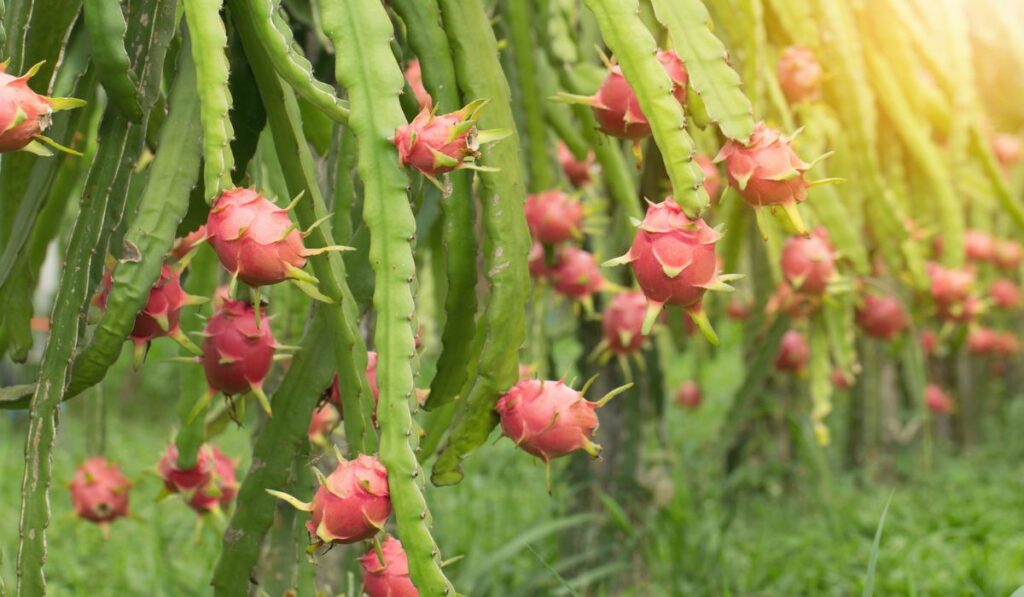Dragon fruit, also known as pitaya, is an incredibly fascinating and exotic fruit that comes from the cactus family. The tropical succulent produces white or pink flowers and spiky fruits that have red, white, or bright purple flesh. As long as you have a warm climate and enough space, you can easily grow a dragon fruit plant at home.
To care for your dragon fruit plant, make sure you add an inch of water every week or once the soil becomes dry to the touch. Place the plant in a sunny spot that receives 6-8 hours of sunlight daily and use well-draining soil. During winter, move your plant to a container and bring it indoors.
While they’re not particularly difficult to grow and maintain, dragon fruit plants are somewhat unique and do require special attention. Let’s look at how often you need to water your dragon fruit plant, why it may not be fruiting, and how much light it needs, so that you can grow and enjoy the sweet fruit in your own garden.
How Often Does a Dragon Fruit Plant Need to Be Watered?
Although dragon fruit plants are cacti, they still require their fair share of water. It’s best to water them as soon as the topsoil becomes dry to the touch, which usually translates to adding an inch of water every week.
However, make sure you factor in the total amount of rainfall your area typically receives to avoid overwatering your dragon fruit plant.
Signs Your Dragon Fruit Plant Isn’t Getting Enough Water

Dragon fruits have a high water content, which means they’ll spoil quickly if they’re not properly cared for. It’s essential to know when the plant isn’t getting enough water, so that you don’t lose any of its delicious fruits. Some of the signs of underwatering include:
Droopy or Wilted Leaves
When a plant doesn’t get enough water, its leaves wilt and droop down toward the ground. If this happens with your dragon fruit plant, check under its leaves for any trapped moisture. If you don’t see any moisture under the leaves, then it’s time to add more water to the soil.
Dry Soil
It can be very easy to forget regularly watering your plant, especially if you live in drier climates, like Southern California or Arizona.
So, if you notice dry soil, water your dragon fruit plant quickly to prevent any further damage from the heat.
Why Your Dragon Fruit Plant Isn’t Fruiting
There are several different reasons why your dragon fruit plant may not be fruiting, including:
Inadequate Growing Conditions
Pitaya is a tropical plant and thrives in heat. If temperatures fall below 65˚F, your plant won’t even be able to form flowers. Once the temperature in your area drops, it’s best to bring the plant indoors or move it to a temperature-controlled greenhouse to induce fruit and flower production.
Lack of Light
A dragon fruit plant needs a lot of light to grow fruits. So, if you’re keeping your plant indoors, it may not be getting enough light.
Make sure you place your plant in an area that receives at least six hours of sunlight every day. If you can’t find such a spot indoors, place your pitaya under bright lights instead.
Lack of Moisture
Since the dragon fruit plant is a cactus, a lot of people assume that it doesn’t need a lot of water — and they couldn’t be more wrong. Pitaya thrives in consistently moist soil, so it’s essential to add around an inch of water to the soil every week.
Keep in mind that dragon fruits usually develop only during summer, when the days are long and temperatures are high. The plant probably won’t develop any fruit during the winter. However, by paying attention to the aforementioned factors, you can increase the fruiting season a bit.
Dragon fruit plants mature quickly, and if maintained properly, can produce fruit for around 20 to 30 years. They’re incredibly long as well and can grow up to 40 feet in length.
You can also encourage fruiting by giving the plant a tall, solid trellis to climb. Make sure you always remove dying or damaged branches and prune the uppermost branches to boost fruit development and encourage more lateral growth.
How Much Light Does a Dragon Fruit Plant Need?

As we mentioned, the dragon fruit plant is a part of the cactus family. Like all other plants in the family, it thrives when it receives six to eight hours of direct sunlight every day. For this reason, make sure you choose a sunny area and measure how hot that spot actually gets.
Dragon fruit plants flourish in temperatures ranging from 65˚F to 77˚F. A bit of variation is, of course, acceptable, but keep in mind that temperatures above 100˚F will damage the fruit.
Prolonged exposure to intense heat and sunlight can also cause sun scald and damage the heat-loving fruit. So, it’s best to place the plant, especially the younger ones, in an area where you’ll be able to provide a bit of shade during the hottest parts of the day.
Can a Dragon Fruit Plant Grow in Any Climate?
If you live in US plant hardiness zones 9, 10, or 11, then you can grow pitaya outdoors all year round. It can survive in winter as well, but it’s better to take a couple of extra measures. If you’ve planted dragon fruit outdoors, adding mulch will protect the soil from excessive temperature variations once the growing season comes around.
However, if you live anywhere else, then it’s best to place the plant in a container and bring it indoors during the winter before the arrival of the season’s first frost.
Keep in mind that temperatures below 32˚F can irrevocably damage the plant. The plant can recover from a small temperature drop, but a sustained and severe frost will kill the plant.
If you’re opting for container planting, then make sure you pick a container that measures at least 15 to 24 inches long and 10 inches deep. It’s also crucial to fill the container with well-draining soil, preferably a loamy or sandy one.
Dragon fruit plants thrive in soil with a pH between 6 and 7, so make sure you adjust the soil accordingly as well.








